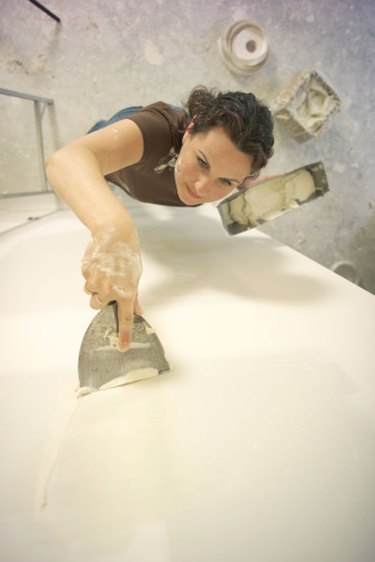
Drywall mud, also known as joint compound, usually covers seams and fills holes in drywall after installation. But crafters use drywall mud for a wide variety of projects, especially those that need a sturdy surface or textured layer. Rhian Brynjolson, author of the 2009 book "Teaching Art: A Complete Guide for the Classroom," writes that drywall mud creates less dust than plaster, so it sometimes is a better option for art projects that need to be sanded or carved.
Home Decor
Video of the Day
Small homemade decorations made with drywall mud are sturdy and reusable. You can coat holiday-themed foam centerpieces with mud, then sand and paint them. Worn or cracked household items -- an old flowerpot, for example -- get affordable facelifts using the same method. The My Halloween Ideas website recommends using building foam insulation to fashion a realistic gravestone: gray-tinted drywall mud provides the top layer with the appropriate texture for an old tombstone.
Video of the Day
Paper Mache
Drywall compound and water together create an adhesive for paper mache. Directions to make a piggy bank at the craft website Free Craft Unlimited include dipping strips of newspaper into that glue mixture and placing them in layers around a balloon, which makes the pig's body. After that dries overnight, the balloon gets popped, and drywall mud then gets slathered over the entire project. It can be sanded or textured, and painted or spray-painted.
Theater Props
The 2005 book "Scenic Art for Theatre: History, Tools and Techniques" by Susan Crabtree, et al., explains that drywall mud is used to make props and theater scenery, and that even detailed work -- decorating a fake cake, for example -- can be done by applying the mud with a pastry bag and tip. Different textures, including tree bark and brick, are made by mixing drywall mud with specific media, such as sand, cocoa mulch or vermiculite.
Models
Any three-dimensional model made with rigid foam, such as a mountain or other topographical feature, can employ drywall compound in its construction. Author Dave Frary writes in his 2005 book, "How to Build Realistic Model Railroad Scenery," that pre-mixed joint compound is one of the few materials that will stick to Styrofoam, so it is often used in the construction of model railroad scenery.
Considerations
Frary warns that joint compound shrinks and cracks if applied too thickly. He also points out that it softens when it gets wet, so it should be sealed it if it might come into contact with water.
- Free Craft Unlimited: Paper Mache Piggy Bank
- "Scenic Art for Theatre: History, Tools and Techniques"; Susan Crabtree, et al.; 2009
- "How to Build Realistic Model Railroad Scenery"; Dave Frary; 2005
- "Teaching Art: A Complete Guide for the Classroom"; Rhian Brynjolson; 2009
- My Halloween Ideas: Making Homemade Tombstone Grave Markers Headstone Props for Your Yard
- Mike Bell's Drywall School: Everything about Drywall Joint Compound(Mud)